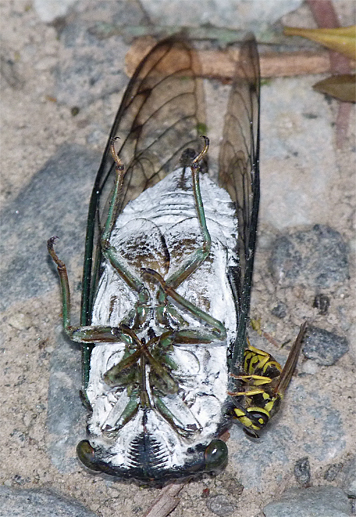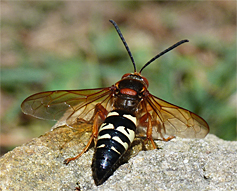
I took the above photo a few weeks ago. I was about to enter my vehicle when I spotted the large insect on the ground directly in front of my van door. The large insect is an Annual Cicada (Cicadidae). The cicada has a wasp attached to it.
“That’s a mighty small Cicada Killer,” I thought out loud.

Of course, I knew the wasp wasn’t a cicada killer (Sphecius speciosus), they’re nearly the same size as a cicada (about 2-2.5 inches including the wings). It was a Yellow jacket (Vespula maculifrons), and I was thinking of how difficult it would be for this little wasp to carry away that cicada. It’s difficult enough for the Cicada Killers to haul around those great big insects, a yellow jacket, no way.
Yellow jackets and Cicada Killers differ in more ways than their size or how much weight they can lift. Cicada Killers are solitary wasps. Most solitary wasps hunt for prey such as spiders, caterpillars, grasshoppers and crickets, and cicadas. They hunt this prey, not to eat themselves but to stock their burrows and nests so that their larval offspring can eat them. The entire paralyzed spider, cricket, or cicada is stuffed into the nest. The female then lays her eggs in or next to the prey item and seals the burrow. From there, the offspring are on their own.
Yellow jackets are social wasps and nest in communal hives. They too hunt for prey to feed to their young, but more often than not they cut small pieces from the prey item, like the one in the photo is attempting to do, and carry the chewed meat back to the hive and feed it directly to the larvae. Besides meat, they also bring pieces of fruits and vegetables back to the hive for the larvae. The young are cared for by the hive members and stay with the colony as it grows.
By the way, you’re more likely to be stung by the little yellow jacket than by the big scary looking cicada killer. In wasps, it’s the social wasps that tend to sting and it’s usually in defence of the the hive or for the well being of the entire colony. The solitary wasps often have to be provoked into stinging. Their stinger is primarily used as a tool for paralyzing prey and not necessarily as a weapon.